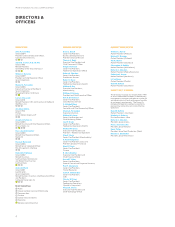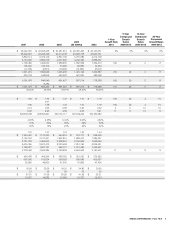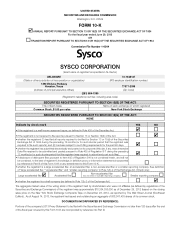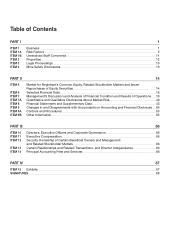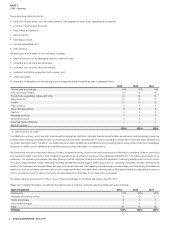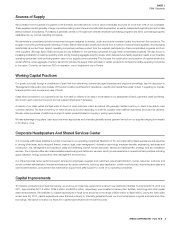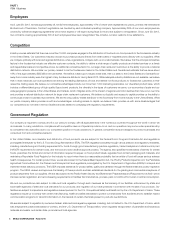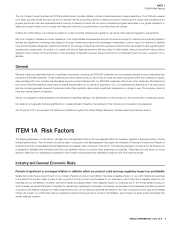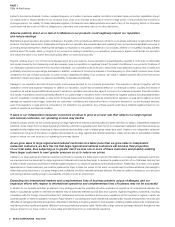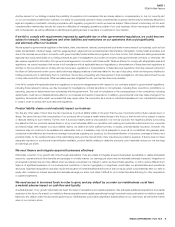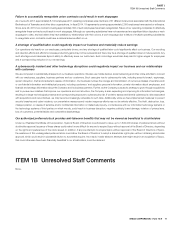Sysco 2013 Annual Report Download - page 16
Download and view the complete annual report
Please find page 16 of the 2013 Sysco annual report below. You can navigate through the pages in the report by either clicking on the pages listed below, or by using the keyword search tool below to find specific information within the annual report.
SYSCO CORPORATION-Form10-K 5
PARTI
ITEM1ARisk Factors
The U.S. Foreign Corrupt Practices Act (FCPA) prohibits bribery of public of cials to obtain or retain business in foreign jurisdictions. The FCPA also requires
us to keep accurate books and records and to maintain internal accounting controls to detect and prevent bribery and to ensure that transactions are
properly authorized. We have implemented and continue to develop a robust anti-corruption compliance program applicable to our global operations to
detect and prevent bribery and to comply with these and other anti-corruption laws in countries where we operate.
Outside the UnitedStates, our business is subject to numerous similar statutes and regulations, as well as other legal and regulatory requirements.
All of our company’s facilities and other operations in the UnitedStates and elsewhere around the world are subject to various environmental protection
statutes and regulations, including those relating to the use of water resources and the discharge of wastewater. Further, most of our distribution facilities
have ammonia-based refrigeration systems and tanks for the storage of diesel fuel and other petroleum products which are subject to laws regulating such
systems and storage tanks. Our policy is to comply with all such legal requirements. We are subject to other federal, state, provincial and local provisions
relating to the protection of the environment or the discharge of materials; however, these provisions do not materially impact the use or operation of our
facilities.
General
We have numerous trademarks that are of signi cant importance, including the SYSCO® trademark and our privately-branded product trademarks that
include the SYSCO® trademark. These trademarks and the private brands on which they are used are widely recognized within the foodservice industry.
Approximately half of our privately-branded sales are from products labeled with our SYSCO® trademark without any other trademark. We believe the
loss of the SYSCO® trademark would have a material adverse effect on our results of operations. Our U.S. trademarks are effective for a ten-year period
and the company generally renews its trademarks before their expiration dates unless a particular trademark is no longer in use. The company does not
have any material patents or licenses.
We are not engaged in material research and development activities relating to the development of new products or the improvement of existing products.
Our sales do not generally uctuate signi cantly on a seasonal basis; therefore, the business of the company is not deemed to be seasonal.
As of June29,2013, we operated 193 distribution facilities throughout the UnitedStates, Bahamas, Canada, Ireland and Northern Ireland.
ITEM1A Risk Factors
The following discussion of “risk factors” identi es the most signi cant factors that may adversely affect our business, operations, nancial position or future
nancial performance. This information should be read in conjunction with Management’s Discussion and Analysis of Financial Condition and Results of
Operations and the consolidated nancial statements and related notes contained in this report. The following discussion of risks is not all inclusive but
is designed to highlight what we believe are the most signi cant factors to consider when evaluating our business. These factors could cause our future
results to differ from our expectations expressed in the forward-looking statements identi ed on page39 and from historical trends.
Industry and General Economic Risks
Periods of signifi cant or prolonged infl ation or defl ation affect our product costs and may negatively impact our profi tability
Volatile food costs have a direct impact on our industry. Periods of product cost in ation may have a negative impact on our pro t margins and earnings
to the extent that we are unable to pass on all or a portion of such product cost increases to our customers, which may have a negative impact on our
business and our pro tability. In addition, periods of rapidly increasing in ation may negatively impact our business due to the timing needed to pass on
such increases, as well as the impact it may have on discretionary spending by consumers. Conversely, our business may be adversely impacted by periods
of product cost de ation because we make a signi cant portion of our sales at prices that are based on the cost of products we sell plus a percentage
margin. As a result, our pro t levels may be negatively impacted during periods of product cost de ation, even though our gross pro t percentage may
remain relatively constant.


